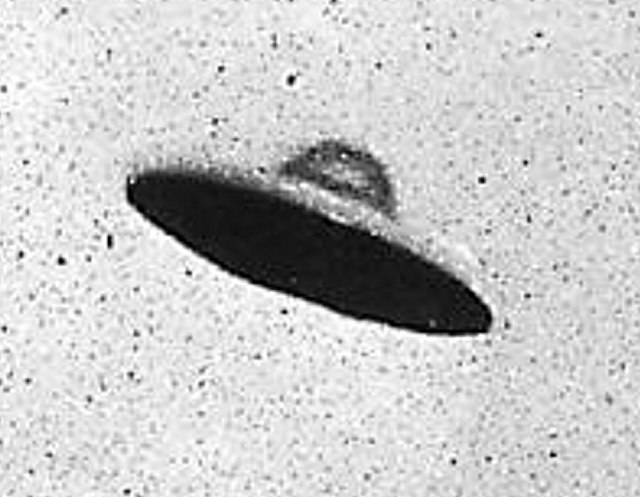Stop talking about UFOs
A supposed imagine of a UFO captured in New Jersey in 1952.
March 14, 2023
It’s late at night in rural America. Suddenly, without warning, bright green lights blast through a farmer’s bedroom window. She gets up, preparing to defend her land from an intruder. Instead, what she sees is a gigantic otherworldly disk levitating above their crops. They watch in awe as the peaceful travelers rapidly ascend into the sky.
That’s the quintessential UFO story. They normally come along with crop circles, green people with big heads, and an eventual “take me to your leader,” but those campfire horror stories are far more dramatic than real UFO sightings.
It’s the mid-afternoon off the coast of Lake Huron. A military officer spots something interesting on his radar, something he can’t explain. A shadowy figure seems to levitate over the lake. Could it be a spy balloon? Perhaps the spacecraft of otherworldly beings?
In the interest of the American public and the world, the only way to keep our species safe is to take swift and aggressive action. Generals order their soldiers to shoot the vessel down. Could their actions lead to a global conflict? Perhaps an interplanetary war?
No. They shot a weather balloon doing research for a local university. These situations are the problem with our country’s feelings towards UFOs.
When Americans think of “UFOs” their minds turn to one thing: Aliens. But the term UFO wasn’t invented to describe an alien spacecraft. The U.S. government created the term to identify anything in our skies we didn’t know the origins of. They could be enemy vessels, but they could also be gender reveal party balloons.
The first famous UFO sighting was in 1947, when a rancher reported a “flying disk” to a nearby Army Air Force base in New Mexico. The Washington Post reported on the story, which quickly became a phenomenon. Similar stories of flying saucers and alien encounters appeared across the country.
Conspiracy theorists, Hollywood writers, and merchandise sellers had a field day with aliens, and the typical UFO sighting became ingrained in popular culture. People’s familiarity with the concept forced the U.S. military to change the term UFO in its lexicon to Unidentified Aerial Phenomena (UAP). UAPs have the same definition as UFOs, but none of the same connotations.
Despite our culture’s misunderstanding and joking about UAP sightings, the U.S. military dutifully investigates them. In 2021, the Pentagon released footage of UAP phenomena they’ve been studying for years. They classified 163 of the 366 total reported UFO sightings as balloons, 26 as drones, 6 as “clutter,” and another 171 as exhibiting strange flying patterns. These are still being investigated.
One of those unexplainable sightings happened in 2004, when Navy pilots Alex Dietrich and Dave Fraver were in a training session 100 miles from San Diego. They witnessed an object with their own eyes that descended 80,000 ft in less than a second, mimicked the pilots’ flight patterns without any visible jets, fans, or wings, and then completely disappeared when it was close enough to be seen. Radar rediscovered the vessel 60 miles away in a matter of seconds. The vessel’s activity is impossible given the government’s knowledge of aircraft technology, but its existence was confirmed by multiple witnesses, infrared capture, and radar scans.
Ignoring the possibility that the object was run by tiny green men, the over 100 other reports still unexplained after investigation by the Pentagon could be incredibly dangerous to U.S. security. If adversarial nations like China or Russia have access to these aircrafts, they could easily destroy our national defense systems. UAPs could be more dangerous to our country’s safety than any other technology on Earth.
But these reports have not received the time and funding they deserve. The Advanced Aerospace Threat Identification Program was created in response to the 2004 sighting, but the program ended in 2012. A similar project began in 2021, but the nation has no idea what UAPs military personnel may have found between 2012 and 2021, or before 2004. What we don’t know about UAPs could leave our nation at risk.
The reason these sightings have barely gotten attention or funding in recent history is the prevalence of UFO stories. Members of Congress and the Pentagon think they’d look ridiculous for investing taxpayer money towards investigating these “silly” stories, but their ignorance towards their actual security threat could put the entire nation at risk.
Classic campfire horror stories about aliens and crop circles can be fun, but they also do a lot of harm. These fantasy stories distract from the real threat UAPs pose to national security. If Americans want to make sure these sightings are given the funding and research they deserve, it’s time to let go of the tiny green men.




